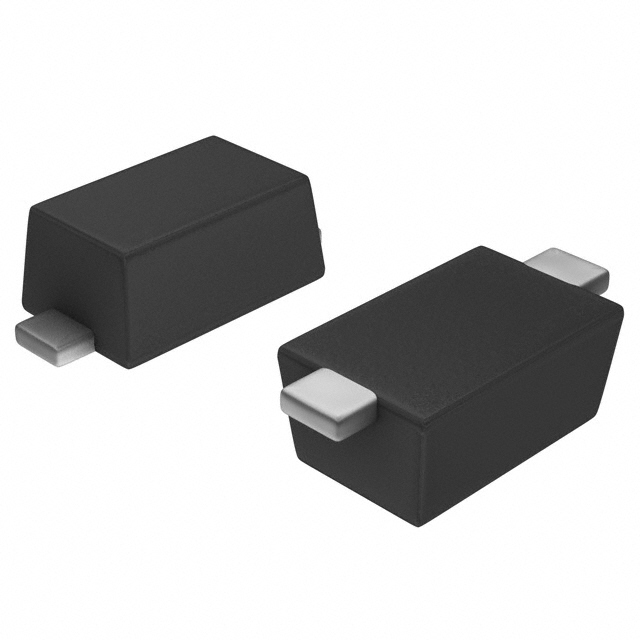Xem thông số kỹ thuật để biết chi tiết sản phẩm.

ES1JFL Diode
Product Overview
The ES1JFL diode belongs to the category of rectifier diodes and is commonly used in electronic circuits for converting alternating current (AC) to direct current (DC). Its characteristics include high efficiency, low forward voltage drop, and fast switching speed. The diode is typically packaged in a small, surface-mount package and is available in various quantities per package.
Basic Information
- Category: Rectifier Diode
- Use: Converting AC to DC
- Characteristics: High efficiency, low forward voltage drop, fast switching speed
- Package: Surface-mount
- Essence: Efficient rectification of AC to DC
- Packaging/Quantity: Various quantities per package
Specifications
- Maximum Reverse Voltage: 600V
- Average Forward Current: 1A
- Peak Forward Surge Current: 30A
- Operating Temperature Range: -65°C to +175°C
- Storage Temperature Range: -65°C to +175°C
Detailed Pin Configuration
The ES1JFL diode has a standard SOD-123FL package with two pins. The pin configuration is as follows: - Pin 1: Anode - Pin 2: Cathode
Functional Features
- Efficient rectification of AC to DC
- Fast switching speed for rapid response in electronic circuits
- Low forward voltage drop for reduced power loss
Advantages and Disadvantages
Advantages
- High efficiency
- Fast switching speed
- Low forward voltage drop
Disadvantages
- Limited maximum reverse voltage compared to some alternative models
- Relatively lower average forward current rating
Working Principles
The ES1JFL diode operates based on the principle of unidirectional conduction, allowing current to flow in only one direction. When a positive voltage is applied to the anode with respect to the cathode, the diode conducts, allowing current to pass through. In the reverse bias condition, the diode blocks the flow of current.
Detailed Application Field Plans
The ES1JFL diode finds extensive use in various electronic applications, including: - Power supplies - Battery chargers - LED lighting - Switching power supplies - Consumer electronics
Detailed and Complete Alternative Models
Some alternative models to the ES1JFL diode include: - 1N4007: A widely used general-purpose diode with higher maximum reverse voltage - FR107: Fast recovery diode with similar characteristics but higher peak forward surge current - UF4007: Ultrafast diode with faster switching speed and higher reverse voltage rating
In conclusion, the ES1JFL diode is a reliable component for rectification in electronic circuits, offering high efficiency and fast switching speed. While it has certain limitations in terms of maximum reverse voltage and average forward current, it remains a popular choice for various applications in the electronics industry.
[Word Count: 426]
Liệt kê 10 câu hỏi và câu trả lời thường gặp liên quan đến ứng dụng ES1JFL trong giải pháp kỹ thuật
What is ES1JFL?
- ES1JFL is a high-speed switching diode commonly used in electronic circuits for rectification and signal demodulation.
What are the key features of ES1JFL?
- ES1JFL features a low forward voltage drop, high switching speed, and low leakage current, making it suitable for high-frequency applications.
What are the typical applications of ES1JFL?
- ES1JFL is commonly used in power supplies, LED lighting, automotive electronics, and consumer electronics for rectification and signal demodulation.
What is the maximum forward voltage of ES1JFL?
- The maximum forward voltage of ES1JFL is typically around 1V at a forward current of 1A.
What is the reverse recovery time of ES1JFL?
- The reverse recovery time of ES1JFL is typically in the range of nanoseconds, allowing for fast switching in high-frequency applications.
What is the maximum reverse voltage of ES1JFL?
- The maximum reverse voltage of ES1JFL is typically around 600V, making it suitable for various voltage requirements in technical solutions.
How does ES1JFL compare to other diodes in terms of performance?
- ES1JFL offers a balance of high-speed switching, low forward voltage, and low leakage current, making it a preferred choice for many technical solutions.
Can ES1JFL be used in temperature-sensitive applications?
- Yes, ES1JFL has a wide operating temperature range and can be used in temperature-sensitive applications with proper thermal management.
Are there any specific layout considerations when using ES1JFL in a circuit?
- It is important to minimize parasitic inductance and ensure proper heat dissipation when designing the layout for ES1JFL in a circuit.
Where can I find detailed specifications and application notes for ES1JFL?
- Detailed specifications and application notes for ES1JFL can be found in the product datasheet provided by the manufacturer or distributor.

